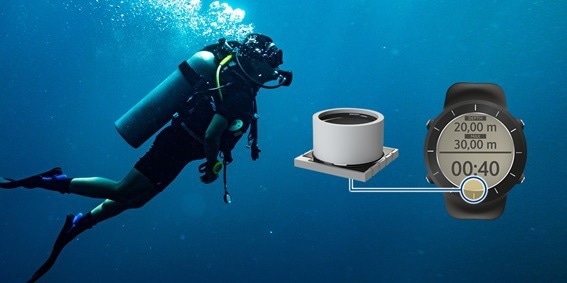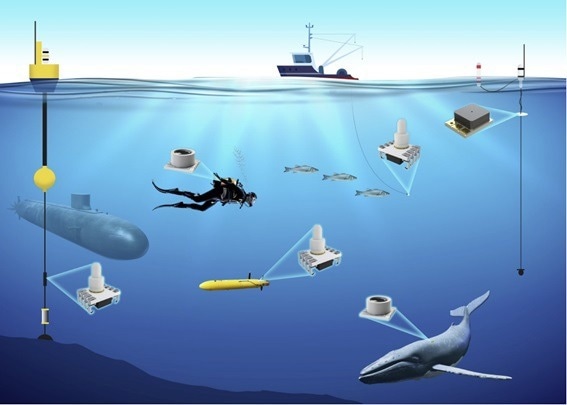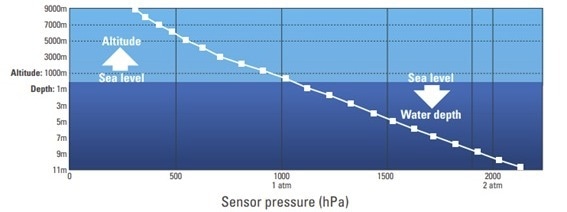Pressure sensors are crucial to ensuring the safe functioning of logistic equipment in a wide range of underwater applications. For scuba diving, an operational depth gauge or diving watch is essential when estimating diving depth and ensuring the ascent and descent are safely performed.
Historically, the majority of dive watches and depth gauges have been analog by design. Digital pressure sensors have a number of significant advantages over analog sensors and have the capacity to be interfaced with dive computers that can combine information from several sensors at the same time.
A digital pressure sensor includes a sensing element; for pressure sensors, this is typically a piezoresistive element and a transducer to transform the sensor response into a digital signal for processing.

Image Credit: Merit Sensor
Digital sensors can be extremely compact, with no moving parts and can be put to use in unforgiving, corrosive environments, such as salt water. Piezoresistive sensors are well-adapted for taking aquatic measurements as they have hardly any restrictions on their operating depths.1
These pressure sensors commonly find application in dive watches, sonar buoys, sometimes known as sonobuoys, tank and ocean depth measurements, and the fishing industry.
Merit Sensor Systems
Merit Sensor Systems leads the way when it comes to developing pressure sensors for many different applications, including diving and freshwater work. Merit Sensor Systems can provide a number of different sensing devices with exceptionally small footprints and ultra-low power draw.
Low power consumption is crucial in remote aquatic applications as devices require a battery that can last for a prolonged period.
For sonar buoys, mobile devices that use sonar signals are deployed to locate passing submarines and marine traffic, as well as to monitor tidal conditions, Merit Sensor Systems has designed a series of pressure sensors that can replace conventional wired technology.
Normally, when deployed, a buoy would be tethered using a spool of wire connecting the device to a float at the surface, and the length of the wire is used to calculate the depth of the device.
However, due to the fact the ocean is in constant flux, the wire displacement can be a poor measure of the depth due to lateral deflections of the device when submerged in water. A digital pressure sensor can offer more accurate depth measurements by measuring the local water pressure.
For sonar buoys, Merit Sensor Systems has a range of suitable sensors on offer, including the HTS 1510 Series, the TR series, and, for more restricted operating depths, the ultra-low power MS series.
All of these sensors are extremely compact and lightweight, meaning they can be easily incorporated into an extensive range of devices while offering hours of continuous operation. The HTS series will also have a Sleep mode built-in in the near future so that the battery life can be preserved for longer.
Each Merit Sensor System is now media compatible in a wide range of water environments and conditions. The MS series is gel-filled for extra protection, and its compact footprint means it can be incorporated into dive watches.
The affordable MS series comes with exceptional stability over a wide temperature range and is compliant with RoHS standards.

Image Credit: Merit Sensor
Calculating Depth
As the water density remains constant in the majority of environments, as does gravity, the underwater pressure is directly relative to the submersion depth. With onboard electronics incorporated for processing, a pressure sensor can quickly translate pressure readings into a measurement of submersion depth or even the local water level.
Diving computers are able to display and process a wide range of pressure information, from diving depth to the gas that remains in breathing tanks. Some dive computers will then be able to determine when is the safest time for a dive and how much time remains during a dive.
All of the Merit Sensor Systems pressure sensor series can be included as part of digital systems, but the HTS 1510 Series includes the choice of both digital or analog outputs.
Crucial for acquiring live depth calculations, all of the pressure sensors include a 10-millisecond start-up time so that the devices can be rapidly rebooted if necessary. Each pressure sensor is lightweight, coming in at less than 2 g in mass, including any protective housing and mounts, which are typically required in saltwater applications.
These pressure sensors have the potential to carry out high accuracy measurements with only 0.5 % FS lifetime drifts and are characterized by extremely low pressure and temperature hysteresis.
Whether looking for a pressure sensor that can withstand the most stringent safety standards for manual diving or a rapid readout sensor for 24/7 online water tank monitoring, Merit Sensor Systems has the appropriate solution on hand.
Each of the HTS 1510 Series, the TR series and the MS series incorporate various designs and housings to optimize them for specific tasks.
The HTS1510 series is a backside-pressure monitor which can be surface-mounted and installed into existing control boards. The fully-compensated TR series is a direct-media pressure monitor developed for plug-and-play compatibility with existing devices, and The MS series is a surface-mounted ceramic device.
Get in touch with Merit Sensor Systems today to learn more about innovative pressure sensors that can be integrated seamlessly into underwater devices.

Image Credit: Merit Sensor
References
- Büttgenbach, S., Constantinou, I., Dietzel, A., & Leester-Schädel, M. (2020). Case Studies in Micromechatronics. In Case Studies in Micromechatronics. https://doi.org/10.1007/978-3-662-61320-7

This information has been sourced, reviewed and adapted from materials provided by Merit Sensor.
For more information on this source, please visit Merit Sensor.